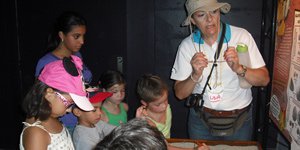By Katherine Hendy
Last year I had the eye-opening experience of helping to design and implement an exhibit on the Geology of Panama at Punta Culebra Nature Center, a branch of the Smithsonian Tropical Research Institute (STRI) in Panama. Punta Culebra had excellent exhibits and interactive learning activities about the marine and terrestrial ecology of Panamá, but it did not have any exhibits about Panama’s unique geology. The emergence of the isthmus of Panama allowed for the interchange of terrestrial faunas between North and South America, as well as divided a once continuous sea into two, changing global climate and ocean circulation.

My time at Punta Culebra was filled with many challenges which were valuable learning experiences with a new language and culture. I did have experience working in education at the Peabody Museum of Natural History at Yale University, but trying to apply those skills in an unfamiliar country while learning a new language was difficult. At first, I would go home feeling victorious if I mastered a new phrase or two, such as how to tell a visitor where the bathroom is located, or reminding children to wash their hands before going to the touch pool. By the end of my time in Panama, I felt comfortable talking to visitors all day long, even with their rapid Spanish.
I worked for eight months in Panama, dividing my time between working as a guide at Punta Culebra, and as a field and lab assistant for the paleontologists in Dr. Carlos Jaramillo’s lab at STRI. I spent countless hours collecting fossils in the field from the Gatún formation, then washing, sorting and identifying them for use in the exhibit. Dr. Austin Hendy helped identify the fossils and designed the poster for the fossil dig we set up as part of the exhibit.
Working on the exhibit was a great way to help bridge the gap between scientists and the public. Most of the STRI geologists had not had opportunities to communicate their knowledge to the general public. The exhibit provided an excellent opportunity for them to share their research with the visitors at Punta Culebra and inspire children to study science. The scientists gave lectures and answered questions in the inauguration day, and Catalina Pimiento designed an interactive web site about fossil sharks. There was excellent collaboration among Lidia de Valencia and the rest of the team at Punta Culebra, and Luz Helena Oviedo and all the scientists from Dr. Jaramillo’s lab. The exhibit opened on one of my last days at Punta Culebra, and it has been a big success. Along with the rest of the exhibits at Punta Culebra, it provides an opportunity for children to experience things they would normally only hear about from teachers or read in textbooks. They get to learn by seeing and touching fossils, along with everything else there is to experience at Punta Culebra. It has helped many Panamanian children (as well as adults) learn about Panama’s importance in geology and paleontology, and hopefully inspires some of those children to become paleontologists one day.
Por Katherine Hendy
El año pasado tuve la experiencia reveladora de ayudar a diseñar e implementar una exhibición sobre la Geología de Panamá en el Centro Natural Punta Culebra, una sucursal del Instituto Smithsonian de Investigaciones Tropicales (STRI) en Panamá. Punta Culebra cuenta con exhibiciones excelentes y actividades de aprendizaje interactivas sobre la ecología marina y terrestre de Panamá, sin embargo, no tenía ninguna exhibición sobre su geología única. El levantamiento del istmo de Panamá permitió el intercambio de faunas terrestres entre Norte y Suramérica, así como la división de un mar antes continuo, cambiando así el clima global y la circulación oceánica.

Mi período en Punta Culebra estuvo lleno de retos las cuales se convirtieron en valiosas experiencias de aprendizaje de un nuevo idioma y cultura. Yo tenía experiencia trabajando en educación en el Museo Peabody de Historia Natural en la Universidad de Yale, pero fue difícil tratar de aplicar esas habilidades en un país desconocido y tratando de entender un nuevo idioma. Al principio llegaba a mi casa sintiéndome victoriosa si aprendía una o dos nuevas frases, por ejemplo, cómo decirle a un visitante donde estaba el baño, o decirle a los niños que se lavaran las manos antes de ir a la piscina interactiva. Felizmente, al final de mi estadía en Panamá, ya me sentía cómoda hablándole a los visitantes todo el día, aún con su español panameño rápido y difícil de entender.
Trabajé por ocho meses en Panamá, dividiendo mi tiempo entre el trabajo como guía en Punta Culebra, y el trabajo como asistente de campo y laboratorio con paleontólogos del laboratorio del Dr. Carlos Jaramillo en STRI. Pasé muchas horas colectando fósiles en la formación Gatún, lavándolos, catalogándolos e identificándolos para usarlos en la exhibición. El Dr. Austin Hendy colaboró en la identificación de los fósiles y diseñó el poster para la mesa de excavación de fósiles que organizamos como parte de la exhibición.
Trabajar en la exhibición fue una buena manera de ayudar a cerrar la brecha entre científicos y el público. Muchos de los geólogos de STRI no habían tenido la oportunidad de comunicarse con el público. Esta exhibición es una excelente oportunidad para que compartan su investigación con los visitantes de Punta Culebra y motivar a los niños hacia la ciencia. Los científicos dieron charlas el día de la inauguración y Catalina Pimiento diseñó una página web interactiva de tiburones fósiles. Hubo una excelente colaboración entre Lidia de Valencia, el resto del equipo en Punta Culebra, Luz Helena Oviedo y todos los científicos del laboratorio del Dr. Jaramillo. La exhibición fue inaugurada uno de mis últimos días en Punta Culebra y ha sido un gran éxito, ya que ha ayudado a muchos niños panameños (y también adultos) a aprender sobre la importancia de la geología y paleontología en Panamá. Seguramente inspirará a algunos de esos niños a ser paleontólogos algún día.